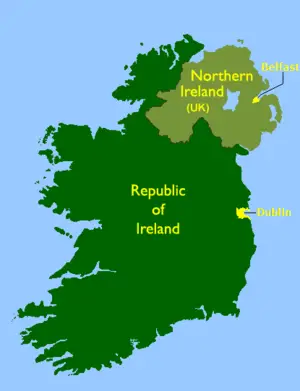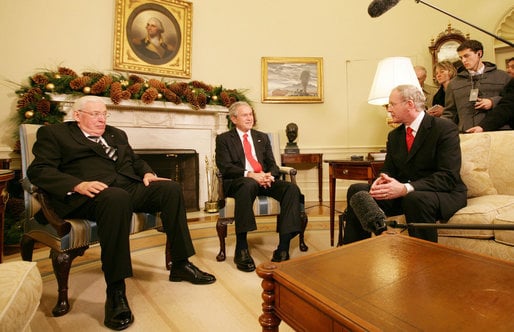Belfast Agreement
The Belfast Agreement , alternatively and widely known as the Good Friday Agreement, and occasionally as the Stormont Agreement was a major political development in the Northern Ireland peace process. The issue was to restore devolved government to Northern Ireland and to end the sectarian violence and conflict between republicans (mainly Catholic) who want union with the Republic of Ireland to re-unite the whole island of Ireland, and loyalists (mainly Protestant) who want to remain within the United Kingdom. It was signed in Belfast on 10 April 1998 (Good Friday) by the British and Irish governments and endorsed by most Northern Ireland political parties. Former US Senator George Mitchell played a leading mediating role during the multi-party talks, which he chaired, starting on June 10, 1996. On 23 May 1998 the Agreement was endorsed by the voters of Northern Ireland in a referendum. On the same day, voters in Ireland voted separately to change their constitution in line with the Agreement. The Democratic Unionist Party (DUP) was the only large party that opposed the Agreement until after the St. Andrews Agrement (October 13, 2006).
Former British Prime Minister John Major had laid some of the groundwork for the Agreement when he issued the 1993 Joint Downing Street Declaration with the Irish Taoiseach, Albert Reynolds and by helping to bring about the the 1994 ceasefire. This enabled Gerry Adams and other leading members of Sinn Féin to join the process. Although the largest of the republican parties, Sinn Féin had been previously excluded because of links with paramilitary organizations. As many of those who had earlier supported violence switched to diplomacy, the prospect of a peaceful solution increased. Decommissioning of the paramilitaries was central to the agreement. Violence has not completely disappeared but a fragile peace has been established. Key to this is the fact that the causes of the divide between the two communities are being addressed while power is shared between both communities, drawing more and more people into the political process. Also key was Ireland's willingness to compromise regarding its territorial claim to the North, and the UK's willingess to concede that the Irish people as a whole had the right to solve the North-South issue by mutual consent.[1] Former enemies are cooperating and working together, even with those whom they previously denounced and demonized due to assurances and mechanisms ensuring social justice written into the Agreement.
The Agreement
Background: "The Troubles"
1993 Downing Street Declaration. Dec. 9, 1994, the first officially sanctioned, publicly announced talks took place between Sinn Fein and British officials. Negotiators for Sinn Fein pushed for a British withdrawal from Northern Ireland; Great Britain countered that the IRA must give up its weapons
The Negotiators
Among the negotiators and power-breakers were:
John Hume of the SDLP. Awarded the 1998 Nobel Prize for his role.
David Trimble of the UUP. Co-winner of the 1998 Nobel Peace Prize for his role.
- Gerry Adams Sinn Féin.JPG
Gerry Adams of Sinn Féin. From 1988 (until the ban was lifted by John Major in 1994) Adam's voice was banned from being broadcast in the UK.
Former British PM, Tony Blair played a leading role during the negotiations.
Ian Paisely, leader of the Democratic Unionist Party was conspicuous by his absence from the process. He initially opposed the Agreement but joined the process following the St. Andrew's Agreement (October 13, 2006) which resolved some remaining issues, then served as First Minister from May 8 2007 until June 5 2008, when he retired.[2]
US President William Jefferson Clinton is recognized as having played a key role. He was not present during the talks but was in close contact with many who were. In 1994 he issued Gerry Adams a visa to visit the US. Visiting Northern Ireland in 1995, he met Adams, famously shaking his hand. In 1996, he appointed Mitchell as US Special Envoy. In September 1998 he again visited Northern Ireland helping to promote the Agreement.[3]
- John-De-Chastelain-1.jpg
Canadian General John-De-Chastelain assisted Mitchell at the talks then chaired the International Commission on Decommissioning from 1997 submitting his report September 25 2005 that the Irish Republican Army has decommissioned the totality of its weapons. He was created a Companion of Honour in 1999, a year after John Major had received the same distinction for his conribution to the Irish peace process.
http://news.bbc.co.uk/2/hi/uk_news/northern_ireland/7297362.stm
Provisions
The Agreement's main provisions included the:
- principle that any change to the constitutional status of Northern Ireland could only follow a majority vote of its citizens;
- commitment by all parties to use "exclusively peaceful and democratic means";
- establishment of a Northern Ireland Assembly with devolved legislative powers;
- cross-community principle for any major decision taken by the Assembly;
- establishment of a 'power-sharing' Northern Ireland Executive, using the D'Hondt method[4] to allocate Ministries proportionally to the main parties;
- establishment of a North-South Ministerial Council and North-South Implementation Bodies to bring about cross-border cooperation in policy and programmes on a number of issues;
- establishment of a British-Irish Inter-governmental Conference (replacing the former Anglo-Irish Inter-governmental Conference, established by the Anglo-Irish Agreement[5]), which gave a consultative role to Ireland concerning matters not devolved.
- establishment of a British-Irish Council, comprising representatives from the governments of Ireland, Northern Ireland, the United Kingdom, the Channel Islands and the Isle of Man;
- conditional early release within two years of paramilitary prisoners belonging to organisations observing a ceasefire.
- establishment of the Northern Ireland Human Rights Commission.
- establishment of a two year timeframe for decommissioning of paramilitary weapons;
- repeal of the Government of Ireland Act 1920 by the British Parliament.[1]
- abolition of the Republic of Ireland's territorial claim to Northern Ireland via the modification of Articles 2 and 3 of its constitution. As a result, the territorial claim which had subsisted since 29 December 1937 was dropped on 2 December 1999;[6]
- introduction of legislation governing policing, human rights and equality in Northern Ireland
- normalisation of security measures, e.g. closure of redundant army bases.
- reform of the police led by the Independent Commission on Policing for Northern Ireland;
- equality of social, economic and cultural rights of all ethnic communities e.g. official recognition of the Irish and Ulster-Scots languages;
- recognition of the birthright of all the people of Northern Ireland to identify themselves and be accepted as Irish or British, or both, as they may so choose; and
- confirmation that the right to hold both British and Irish citizenship is accepted by both Governments and would not be affected by any future change in the status of Northern Ireland.
The Agreement also marked the end of a dispute between the two states over the names of their respective states: the United Kingdom of Great Britain and Northern Ireland and Ireland. Vague wording of some of the provisions (described as "constructive ambiguity"), which helped ensure acceptance of the agreement at the time, served to postpone debate on some of the more contentious issues—most notably paramilitary decommissioning, police reform and normalisation. A date of May 2000 was set for total disarming of all paramilitary groups. This was not achieved and delayed the establishment of the Assembly and Executive, because one of the four main parties in the Assembly—Sinn Féin—was "inextricably linked" to the largest paramilitary group, the Provisional Irish Republican Army (PIRA), and unionists refused to share power with this party, while the PIRA remained armed.
Referenda
In May 1998, there were separate referenda concerning the Belfast Agreement The referendum in Northern Ireland was a direct vote on the Agreement while the vote in Ireland was a vote to amend the Irish constitution in line with the Belfast Agreement.
The result of these referenda was a large majority in both parts of the island of Ireland in favour of the Agreement.
In the Republic only 85,748 (3% of the electorate) voted 'No' but approximately 40% of the electorate did not exercise their franchise.
In the North, when normal combined voting strengths among both nationalist and unionist communities are superimposed on the Referendum result, it is clear that pre-polling opinion polls and exit polls on the day were correct in showing that a majority of the unionist voters voted 'Yes'. The DUP claim to have been at that point 'a majority of the majority' was clearly difficult to substantiate although in later events they succeeded in so becoming.
In the Republic of Ireland the electorate voted upon the nineteenth amendment to the Constitution of Ireland. This amendment both permitted the state to comply with the Belfast Agreement and provided for the removal of the 'territorial claim' contained in Articles 2 and 3. Ireland voted upon the Amsterdam Treaty on the same day.[7] The results of the two simultaneous referenda on the Belfast Agreement were as follows:
| Turnout | Yes | No | |
|---|---|---|---|
| Northern Ireland | 81% | 676,966 (71%) | 274,879 (29%) |
| Republic of Ireland | 56% | 1,442,583 (94%) | 85,748 (6%) |
The Northern Ireland Assembly
The Assembly and Executive were eventually established in December 1999 on the understanding that decommissioning would begin immediately, but were suspended within two months due to lack of progress, before being re-established in May 2000 as Provisional IRA decommissioning eventually began. Trimble became First Minister on July 1st 1998. He resigned in July 2001 but was re-elected in September. Aside from the decommissioning issue, however, ongoing paramilitary activity (albeit relatively low level compared to the past) by the Provisional Irish Republican Army—e.g., arms importations, smuggling, organized crime, "punishment beatings," intelligence-gathering and rioting—was also a stumbling block. The loyalist paramilitaries also continued similar activity although as they were not represented by a significant political party, their position was less central to political change.
The overall result of these problems was to damage confidence among unionists in the Agreement, which was exploited by the anti-Agreement DUP which eventually defeated the pro-Agreement Ulster Unionist Party (UUP) in the 2003 Assembly election. The UUP had already resigned from the power-sharing Executive in 2002 following arrests of Sinn Féin personnel on charges of gathering intelligence for use by terrorists. (These charges were eventually dropped in 2005 on the controversial grounds that pursual would not be "in the public interest." Immediately afterwards, one of the accused Provisional Sinn Féin members, Denis Donaldson was exposed as a British agent.) In October, 2002 the Assembly and Executive and First Ministerehip were suspended.
In 2004, negotiations were held between the two governments, the DUP, and Sinn Féin on an agreement to re-establish the institutions. These talks failed, but a document published by the governments detailing changes to the Belfast Agreement became known as the 'Comprehensive Agreement'. On 26 September 2005, however, it was announced that the Provisional Irish Republican Army had completely decommissioned its arsenal of weapons and "put them beyond use." Nonetheless, many unionists, most notably the DUP, remained sceptical and agreement on how to restore the power-sharing assembly still had not been reached as of July 2006. Of the loyalist paramilitaries, only the Loyalist Volunteer Force (LVF) had decommissioned any weapons under the oversight of the International Commission on Decommissioning, chaired by General John de Chastelain.[8]
St Andrews' Agreement
Talks were held at St Andrews in Scotland between October 11 and 13 in which Admas and Paisley participated. One of the main aims was to resolve issues that prevented the DUP from joining a power-sharing administration. This included assurances that Sinn Féin would recognize the new police service for Northern Ireland. Agreement was reached and on May 8 2007, a Power Sharing Executive was again been established to govern Northern Ireland in devolved matters. The second Northern Ireland Executive consisted of the DUP and Sinn Féin, with the Rev. Dr. Ian Paisley of the DUP as First Minister and Martin McGuiness of Sinn Féin as Deputy First Minister. Although Dr. Paisley was the head of the government, he and Martin McGuiness held equal powers within the Northern Ireland Assembly government.
Dr Paisley, getting on in years, retired from the office of First Minister and from the leadership of the DUP on 5 June 2008 and was succeeded in both functions by Peter Robinson. In the third Northern Ireland Executive the same political relationship now exists between Mr Robinson and Mr McGuinness as existed formerly between Dr Paisley and Mr McGuinness. Visiting George W. Bush in Washington, DC with the First Minister, Paisley, McGuiness is reported to have said that before they began to work together they had never had a conversation about anything, not even the weather but now they got on well and had never exchanged a single angry word.[9] Paisley also developed a positive relationship with the Irish PM, Bertie Ahern.
Legacy
Notes
- ↑ This was set out in the Downing St. Declaration.
- ↑ These issues included acceptance of the new police service for Northern Ireland by Sinn Féin and the DUP agreeing to the power-sharing arrangement.
- ↑ Clinton: His role in Northern Ireland.] BBC News, December 11, 2000. Retrieved August 2, 2008.
- ↑ System devised by Victor D'Hondt, a Belgian mathematician.
- ↑ Governemnt of Ireland and Governme of the United Kingdom. 1985. Article 2, Anglo-Irish Treaty CAIN (Conflict Archive on the Internet). Retrieved August 4, 2008.
- ↑ Andrews, David. 1999.Address by Mr David Andrews, Irish Minister for Foreign Affairs at the Exchange of Notifications ceremony at Iveagh House, Dublin, 2 December 1999. CAIN (Conflict Archive on the Internet). Retrieved August 4, 2008.
- ↑ The Treaty of Amsterdam was an amendment to the treaty creating the European Union. Signed on October 2, 1997, it introduced a number of significant changes made substantial including greater stress on individual rights, enhanced powers for the European Parliament thus strengthening democracy and what has been described as the beginning of a common EU foreign and security although not defense policy, among other developments.
- ↑ Paramilitary Arms Destroyed.. BBC News. December 18, 1998. Retrieved August 4, 2008.
- ↑ Purdy, Martina. 2007."Charming Ministers" woo President. BBC News. December 8. Retrieved August 4, 2008.
ReferencesISBN links support NWE through referral fees
- Aughey, Arthur. 2005. The politics of Northern Ireland: beyond the Belfast Agreement. London: Routledge. ISBN 9780415327879
- Moran, Jon. 2008. Policing the Peace In Northern Ireland Politics, Crime and Security After the Belfast Agreement. Manchester: Manchester Univ Press ISBN 9780719074714
- Morgan, Austen. 2000. The Belfast Agreement: a practical legal analysis. London: Belfast Press. ISBN 9780953928705
- Wilford, Rick. 2001. Aspects of the Belfast Agreement. Oxford: New York. ISBN 9780199242627
- Wilford, Rick, and Robin Wilson. 2006. The trouble with Northern Ireland: the Belfast Agreement and democratic governance. TASC at New Island pamphlet series, 3. Dublin: New Island. ISBN 9781905494279
External links
- The St Andrews' Agreement The latest attempt to restore devolution to Northern Ireland
- North-South Ministerial Council/An Chomhairle Aireachta Thuaidh/Theas
- Belfast Agreement (full text)
- British-Irish Council
- Inside Out: An Integrative Critique of the Northern Ireland Peace Process U.S. Institute of Peace July 2006
- Address given at the Exchange of Notifications ceremony, whereby Ireland dropped its territorial claim to Northern Ireland, Iveagh House, Dublin, 2 December 1999
Credits
New World Encyclopedia writers and editors rewrote and completed the Wikipedia article in accordance with New World Encyclopedia standards. This article abides by terms of the Creative Commons CC-by-sa 3.0 License (CC-by-sa), which may be used and disseminated with proper attribution. Credit is due under the terms of this license that can reference both the New World Encyclopedia contributors and the selfless volunteer contributors of the Wikimedia Foundation. To cite this article click here for a list of acceptable citing formats.The history of earlier contributions by wikipedians is accessible to researchers here:
The history of this article since it was imported to New World Encyclopedia:
Note: Some restrictions may apply to use of individual images which are separately licensed.








